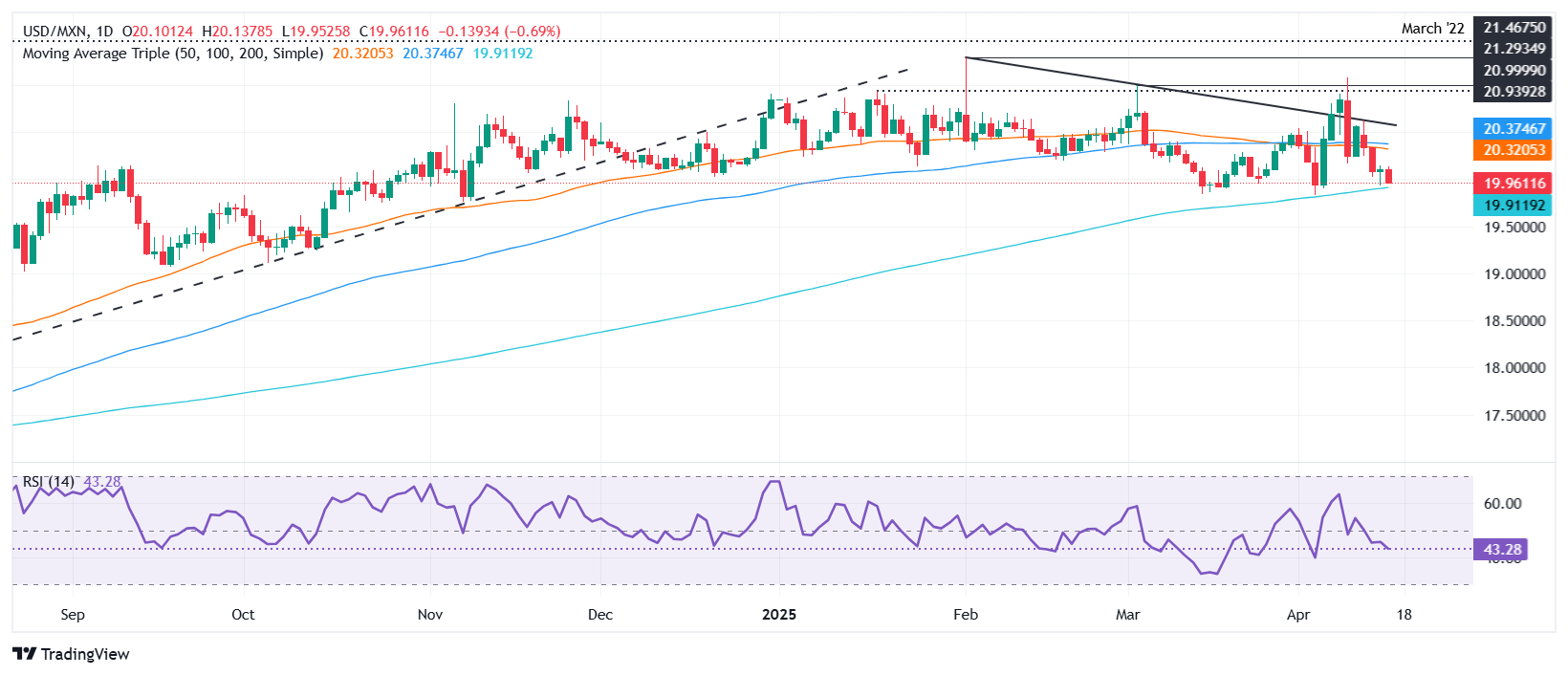- The Mexican peso shows 0.58% while the USD/MXN falls below 20.00 in a negative risk tone and a weak US dollar.
- Powell points out caution about inflation, mentions downward risks and a solid labor market; The Fed is expected to keep the stable rates.
- China Q1 GDP exceeds forecasts, promoting emerging market currencies; Chips exports restrictions affect the US technological sector and NASDAQ.
- Sheinbaum minimizes US tariffs on tomatoes, says Mexico remains a key supplier amid commercial tensions.
The Mexican peso continues to be seen against the US dollar while the market appetite remains negative, while the president of the Fed, Jerome Powell, emphasized that it remains slightly focused on inflation since the economy is close to the maximum employment. At the time of writing, the USD/MXN trades at 19.96, with a fall of 0.58%.
The mood of the market is pessimistic since fears about tariffs persist. The imposition of restrictions on the part of the US to Chip exports to China weighed on the main semiconductor companies, sending Nasdaq, which is very focused on technology, downward. Despite this, the data of the Gross Domestic Product (GDP) of China, which were better than expected in the Q1 of 2025, promoted the currency of emerging markets (EM) as the weight.
Powell said politics is well positioned, adding that the economy is “solid” despite uncertainty and downward risks. He affirmed that growth was probably slowed in the Q1 of 2025, generating the possibility of a stagflation scenario, after saying: “The two objectives of the Fed are not yet in tension, but the impulse is towards greater unemployment and greater inflation.”
Meanwhile, the president of Mexico, Claudia Sheinbaum, continued to negotiate with her American counterpart to avoid Trump’s highest tariffs and said that 20.91% tariffs on tomatoes will not be carried out. He added: “This process has been carried out many times, and Mexico has always won. But even if this sanction was applied, Mexican tomatoes would continue to export to the United States because there is no substitute; the main problem would be that tomatoes would be more expensive in the United States.”
On the other side of the border, US retail sales were better than expected, while the US industrial production was contracted more than expected.
On the agenda, Mexico will present retail sales, inflation in the middle of the month for April and the economic activity of February until next week. In the US, data on housing and initial unemployment applications on Thursday will be revealed.
What moves the market today: the Mexican weight advances in the middle of an absent economic agenda
- The retail sales of Mexico in January were 0.6% monthly and 2.7% year -on -year. If the data fall below those figures, it would be another sign that the economy is slowing down, as mentioned by the governor of the Bank of Mexico (Banxico), Victoria Rodríguez Ceja.
- Before the Senate, Victoria Rodríguez Ceja said that the Governing Board is still unsatisfied with the inflation rate, which stood at 3.8% year -on -year in March, although far from the objective of 3%. He added that the process of disinflation and economic deceleration justify the moderate approach of Banxico and suggested that the Central Bank could continue to relax the policy.
- A reduction in the differential of interest rates between Mexico and the United States suggests that a greater increase in the USD/MXN exchange rate is expected. This is because Banxico is expected to reduce the rates at 50 basic points (PBS) at the May meeting, while the first Fed movement is projected for July.
- The monetary market participants had incorporated 91 PBS of relaxation by the FED towards the end of 2025. The first cut is expected to be in July.
- The US retail sales increased by 1.4% monthly in March, exceeding 1.3% expectations and were significantly higher than 0.2% in February, driven by strong car sales. However, the control group, which feeds GDP calculations, increased only 0.4%, below 1.3%in February and below the 0.6%prognosis.
- The Federal Reserve revealed that US industrial production fell 0.3% after an increase of 0.8% in February.
Technical perspective of the USD/MXN: The Mexican weight gains ground while the USD/MXN falls below 20.00
The USD/MXN bullish trend remains intact, although the torque slides below the level of 20.00. Sellers seem willing to try the 200 -day SMA in 19.86, but they will need to overcome it in a daily closure, so they could remain hopeful to challenge the 19.50 figure. In that case, the following support would be 19.00.
On the contrary, if buyers push the USD/MXN exchange rate above 20.00, this could open the door to test the maximum of April 14, 20.29, which would open the door to the confluence of the 50 -day and 100 days SMA about 20.30–20.36, followed by the resistance of 20.50. Overcoming these levels could lead to a new test of the Pico de Abril at 21.07.

Mexican weight FAQS
The Mexican weight (MXN) is the most commercialized currency among its Latin American peers. Its value is widely determined by the performance of the Mexican economy, the country’s central bank policy, the amount of foreign investment in the country and even remittance levels sent by Mexicans living abroad, particularly in the United States. Geopolitical trends can also affect MXN: for example, the Nearshoring process (or the decision of some companies to relocate the manufacturing capacity and supply chains closer to their countries of origin) is also considered a catalyst for the Mexican currency, since the country is considered a key manufacturing center in the American continent. Another catalyst for MXN is oil prices, since Mexico is a key exporter of the raw material.
The main objective of the Central Bank of Mexico, also known as Banxico, is to maintain inflation at low and stable levels (in or close to its 3%target, the midpoint of a tolerance band between 2%and 4%). To do this, the bank establishes an adequate level of interest rates. When inflation is too high, Banxico will try to control it by raising interest rates, which makes the indebtedness of homes and companies more cooling, thus cooling the demand and the economy in general. The highest interest rates are generally positive for Mexican weight (MXN), since they lead to higher yields, which makes the country a more attractive place for investors. On the contrary, lower interest rates tend to weaken the MXN.
The publication of macroeconomic data is key to evaluating the state of the economy and can have an impact on the valuation of the Mexican weight (MXN). A strong Mexican economy, based on high economic growth, low unemployment and high confidence is good for MXN. Not only attracts more foreign investment, but it can encourage the Bank of Mexico (Banxico) to increase interest rates, particularly if this fortress is accompanied by high inflation. However, if the economic data is weak, the MXN is likely to depreciate.
As an emerging market currency, the Mexican weight (MXN) tends to rise for periods of risk, or when investors perceive that the general market risks are low and, therefore, are eager to participate in investments that carry a higher risk. On the contrary, the MXN tends to weaken at times of market turbulence or economic uncertainty, since investors tend to sell higher risk assets and flee to the most stable safe shelters.
Source: Fx Street
I am Joshua Winder, a senior-level journalist and editor at World Stock Market. I specialize in covering news related to the stock market and economic trends. With more than 8 years of experience in this field, I have become an expert in financial reporting.






